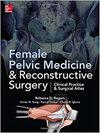The Impact of Local Estrogen on the Urogenital Microbiome in Genitourinary Syndrome of Menopause: A Randomized-Controlled Trial
IF 1.4
4区 医学
Q3 OBSTETRICS & GYNECOLOGY
Female Pelvic Medicine and Reconstructive Surgery
Pub Date : 2022-04-15
DOI:10.1097/SPV.0000000000001170
引用次数: 4
Abstract
Importance The postmenopausal urinary bladder microbiome is not well defined. Objectives The aims of this study were to characterize the effect of vaginal estrogen on the vaginal and urinary bladder microbiome in postmenopausal women and describe any clinical associations with the symptoms of genitourinary syndrome of menopause. Study Design This was a participant-masked, randomized controlled trial comparing the effect of a 12-week course of an estrogen-containing vaginal ring to a placebo vaginal ring. Standardized evaluations were performed at baseline and 12 weeks. Vaginal samples were obtained for pH, vaginal maturation index, and microbiome analysis. Concomitant catheterized urine samples were obtained for microbiome analysis. 16S ribosomal RNA gene sequencing was performed to characterize the resident microbial communities, with Lactobacillus relative abundance as the primary outcome variable. Genitourinary syndrome of menopause symptoms was measured using validated questionnaires (Pelvic Floor Distress Inventory–Short Form, Female Sexual Function Index, Vulvovaginal Symptoms Questionnaire). Results Of the 39 postmenopausal women randomized, baseline characteristics were similar between arms, with a mean age of 62 years and mean vaginal pH of 5.0. Using intention-to-treat analysis, there were no significant changes in vaginal or urinary Lactobacillus relative abundance. Two participants in each arm removed their ring prior to the end of the study. Eighty percent of participants experienced at least 1 bothersome genitourinary syndrome of menopause symptom. Vulvovaginal dryness and urinary frequency were most common at baseline, whereas painful intercourse and urinary urgency were most common at the final visit, none of which were statistically significant. Conclusions Our study did not show a significant change in the bacterial composition of the vaginal or urinary bladder microbiome after either vaginal ring in this relatively asymptomatic postmenopausal population.雌激素对更年期泌尿生殖系统综合征患者泌尿生殖系统微生物组的影响:一项随机对照试验
重要性绝经后膀胱微生物组尚未明确。目的本研究的目的是描述阴道雌激素对绝经后妇女阴道和膀胱微生物组的影响,并描述与更年期泌尿生殖系统综合征症状的任何临床关联。研究设计这是一项受试者蒙面随机对照试验,比较了含雌激素阴道环与安慰剂阴道环12周疗程的效果。在基线和12周时进行标准化评估。采集阴道样本进行pH值、阴道成熟指数和微生物组分析。同时采集导尿管尿液样本进行微生物组分析。16S核糖体RNA基因测序用于表征常驻微生物群落,乳酸杆菌相对丰度是主要结果变量。使用经验证的问卷(盆底疼痛量表-简式、女性性功能指数、外阴阴道症状问卷)测量更年期症状的泌尿生殖系统综合征。结果39名绝经后妇女随机分组,各组基线特征相似,平均年龄62岁,阴道平均pH值5.0。使用意向治疗分析,阴道或尿液中乳酸杆菌的相对丰度没有显著变化。每只手臂上有两名参与者在研究结束前摘下了戒指。80%的参与者至少经历过一次令人烦恼的更年期泌尿生殖系统综合征症状。外阴阴道干燥和尿频在基线时最为常见,而性交疼痛和尿急在最后一次就诊时最为普遍,这些都没有统计学意义。结论我们的研究没有显示,在这个相对无症状的绝经后人群中,阴道环或膀胱环后,阴道或膀胱微生物组的细菌组成没有显著变化。
本文章由计算机程序翻译,如有差异,请以英文原文为准。
求助全文
约1分钟内获得全文
求助全文
来源期刊

Female Pelvic Medicine and Reconstructive Surgery
OBSTETRICS & GYNECOLOGY-
CiteScore
2.10
自引率
12.50%
发文量
228
期刊介绍:
Female Pelvic Medicine & Reconstructive Surgery, official journal of the American Urogynecologic Society, is a peer-reviewed, multidisciplinary journal dedicated to specialists, physicians and allied health professionals concerned with prevention, diagnosis and treatment of female pelvic floor disorders. The journal publishes original clinical research, basic science research, education, scientific advances, case reports, scientific reviews, editorials and letters to the editor.
 求助内容:
求助内容: 应助结果提醒方式:
应助结果提醒方式:


